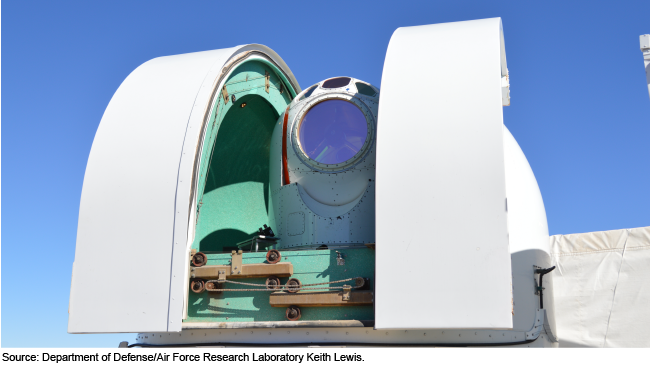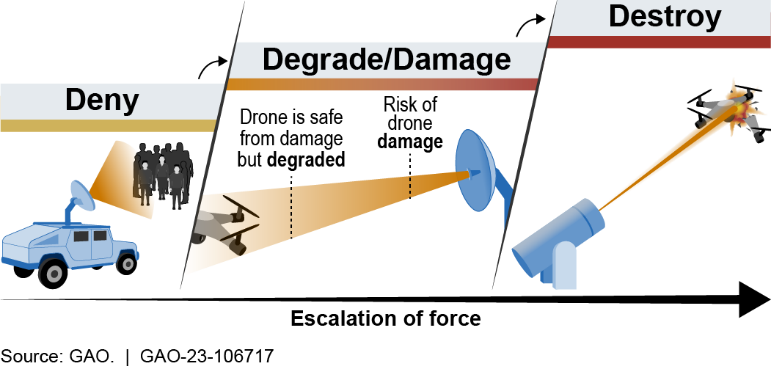Science & Tech Spotlight: Directed Energy Weapons
Fast Facts
Directed energy weapons—such as lasers—use energy fired at the speed of light. These weapons can produce force that ranges from deterrent, to damaging, to destructive. Many countries, including the U.S., are researching their use.
Because they use energy instead of bullets or missiles, directed energy weapons could be less expensive per shot and have virtually unlimited firing power.
However, the long-term health effects of these weapons are unclear. They also generally have a shorter range than conventional weapons, and weather conditions—such as fog and storms—can make certain directed energy weapons less effective.
Demonstrator Laser Weapon System at the White Sands Missile Range, New Mexico

Highlights
Why This Matters
There is a surge in interest in directed energy weapons from several nations—including the U.S.—primarily for counter drone missions. These weapons use electromagnetic energy to cause effects ranging from deterrence to destruction. They offer capabilities that conventional weapons may not, but challenges have so far prevented widespread operational use.
The Technology
What is it? Directed energy weapons (DEW) use concentrated electromagnetic energy to combat enemy forces and assets. These weapons include high energy lasers and other high power electromagnetics—such as millimeter wave and high power microwave weapons. Unlike weapons that fire bullets or missiles, DEWs can respond to a threat in different ways. For example, they can temporarily degrade electronics on a drone or physically destroy it. See our 2022 Spotlight for more information on counter-drone technology.
How does it work? Each type of DEW uses a different region of the electromagnetic spectrum (see fig. 1). This spectrum describes all of the kinds of light—including those the human eye cannot see—and classifies them according to wavelength. Different types of electromagnetic energy have different properties. For example, the wavelength affects what the directed energy can penetrate—such as metal or human skin.

Figure 1. Location of directed energy weapons on the electromagnetic spectrum.
All DEWs emit energy at the speed of light, and are often discussed in terms of their power output—the amount of electromagnetic energy transferred over time. While DEWs use electromagnetic energy similar to everyday items, such as household microwaves, their power output is vastly higher, as described below.
High energy lasers produce a very narrow beam of light, usually in the infrared to visible region, and are typically used on one target at a time. The beam can be pulsed or continuous, generating a power output of at least 1 kilowatt. This output is 200,000 times greater than a typical laser pointer and is capable of melting steel.
Millimeter wave weapons have wavelengths between 1 and 10 millimeters and generate more than 1 kilowatt of power. Millimeter wave weapons have a larger beam size than high energy lasers and therefore can affect multiple targets at once.
High power microwave weapons produce microwaves, which have longer wavelengths than high energy lasers and millimeter wave weapons. These weapons can produce more than 100 megawatts of power, which is nearly 150,000 times more powerful than the average household microwave. Like millimeter wave weapons, they can also affect multiple targets because of their larger beam size.
Each DEW can produce a range of effects from nonlethal to lethal, depending on factors such as the time on target, the distance to the target, and even the part of the target on which the DEW is focused. DEWs can use this range of effects to graduate responses to a threat. A graduated response could start with temporarily preventing use of an asset or its access to an area and increase to destruction of the asset if necessary (see fig. 2).

Figure 2. Examples of graduated responses using directed energy weapons.
DEWs can deny entrance to an area or prevent enemy forces or assets from functioning within an area. DEWs used for denial do not cause long-term damage to targets, and when enemy forces or assets leave the area, they typically regain function or the effect is mitigated. For example, the Department of Defense's (DOD) Active Denial System uses millimeter waves that interact with the water and fat molecules in a person's skin to create a heating sensation. During testing, the discomfort persuaded individuals to move away from the area.
DEWs can also degrade the efficacy of an enemy's assets. For example, high energy lasers can temporarily overwhelm a person or a sensor's ability to see or sense by emitting a glare—called dazzling. Dazzling can act as a non-verbal warning before resorting to increased force.
If a greater amount of force is required, DEWs can also damage or destroy enemy assets. To do this, a high energy laser can emit electromagnetic energy with a wavelength the target material absorbs most effectively, melting the material. The laser could focus on a sensor and damage a drone, or focus on a fuel tank or battery and destroy it.
How mature is it? DEWs range in maturity from research projects to prototypes tested in the field. DOD named DEWs as a technology critical to enabling the 2018 National Defense Strategy and reported spending about $1 billion annually for the last 3 years on research and development. The U.S. military has tested a variety of DEW prototypes since 2014, primarily for counter-drone missions. For example, the Air Force’s prototype Tactical High Power Microwave Operational Responder (THOR) recently completed 2 years of testing. DOD is researching ways to increase the power output of DEWs to engage more powerful targets—like missiles. However, as GAO recently reported, the U.S. military faces challenges bridging the gap between DEW development and acquisition, potentially limiting widespread operational use.
Why now? DEW research and development has been ongoing for decades in many countries—including the U.S.—and is currently experiencing a surge worldwide. This surge stems in part from advances in technology and a desire to maintain competitiveness on the battlefield. Technological innovations, such as the development of smaller lasers that are safer to operate, enable modern DEWs to be much more portable and practical. For example, a four-wheel all-terrain vehicle can now hold a high energy laser powerful enough to damage drones. The U.S. and 30 other nations are developing DEWs, most for counter-drone missions, according to a 2021 Air Force report.
Opportunities
- Complement to conventional weapons. DEWs use energy fired at the speed of light, making them faster and potentially less costly per shot than missiles. Some DEWs have virtually unlimited ammunition and can fire as long as they have power.
- Ease of graduated response. DOD can tailor DEWs to meet mission needs from nonlethal to lethal responses. For example, the longer a laser is focused on target, the more damage or destruction will occur.
- Advancing other uses. Research and development for DEWs could also benefit civilian uses. For example, the development of higher energy lasers could help projects that use directed energy to transport or “beam” power to remote and disadvantaged locations.
Challenges
- Technological limitations. DEWs are generally less effective the farther they are from the target, and atmospheric conditions and cooling requirements can limit their effectiveness. For example, fog and storms can reduce laser beam range and quality.
- Battlefield use. Decisions about how and when to use DEWs or conventional weapons may be challenging. For example, wider beam DEWs, such as high power microwave or millimeter wave weapons, affect all assets in an area, whether friend or foe.
- Ethical and health concerns. Although there are potentially relevant international laws and guidelines, their applicability to DEWs is not always well defined. Uncertainty around long-term health effects of DEWs on people either intentionally or unintentionally exposed to directed energy has led to concerns regarding the ethics of using DEWs.
Policy Context and Questions
- As the technology matures, what actions could policymakers take to help bridge the gap between DEW development and acquisition?
- What actions could policymakers take to ensure there is appropriate guidance for using DEWs as the technology matures?
- What are the trade-offs of using nonlethal DEW technologies before potential health effects are fully understood?
For more information, contact: Brian Bothwell at (202) 512-6888 or bothwellb@gao.gov.
